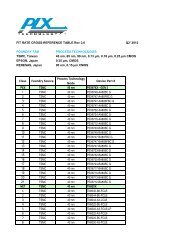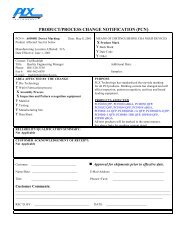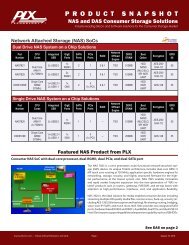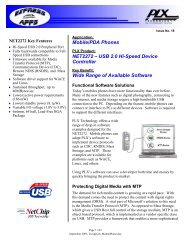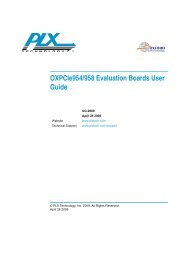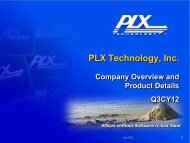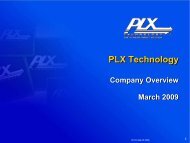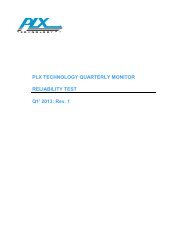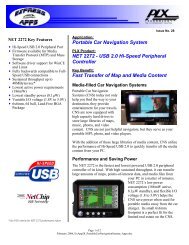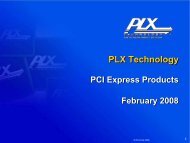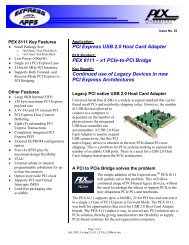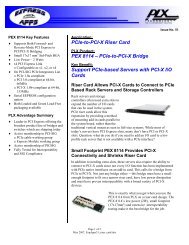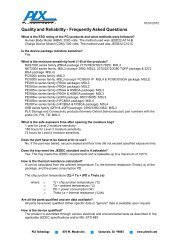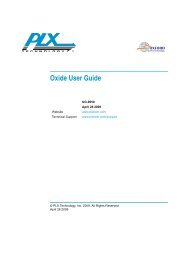the 2009 Annual Report (pdf) - PLX Technology
the 2009 Annual Report (pdf) - PLX Technology
the 2009 Annual Report (pdf) - PLX Technology
You also want an ePaper? Increase the reach of your titles
YUMPU automatically turns print PDFs into web optimized ePapers that Google loves.
continue indefinitely. The high turns fill orders pattern, toge<strong>the</strong>r with <strong>the</strong> uncertainty of product mix and pricing,<br />
makes it difficult to predict future levels of sales and profitability and may require us to carry higher levels of<br />
inventory.<br />
Gross Margin. Gross margin represents net revenues less <strong>the</strong> cost of revenues. Cost of revenues primarily<br />
includes <strong>the</strong> cost of (1) purchasing semiconductor devices from our independent foundries, (2) packaging, assembly<br />
and test services from our independent foundries, assembly contractors and test contractors and (3) our operating<br />
costs associated with <strong>the</strong> procurement, storage and shipment of products as allocated to production.<br />
Years Ended December 31,<br />
<strong>2009</strong> 2008 2007<br />
in thousands<br />
Gross profit…………………………………………… $ 46,932 $ 48,282 $ 49,525<br />
Gross margin………………………………………… 56.7% 59.6% 60.6%<br />
Gross profit for <strong>the</strong> year ended December 31, <strong>2009</strong> decreased by 2.8%, or $1.4 million compared to 2008. The<br />
decrease in absolute dollars and as a percentage was primarily due to <strong>the</strong> lower margins of <strong>the</strong> Storage products<br />
acquired in <strong>the</strong> Oxford acquisition as well as overall product mix.<br />
Gross profit for <strong>the</strong> year ended December 31, 2008 decreased by 2.5%, or $1.2 million compared to 2007. The<br />
decrease in absolute dollars and as a percentage was primarily due to decreased Connectivity product shipments and<br />
increased product shipments and customer mix of our PCI Express products, which have lower margins relative to<br />
our Connectivity products.<br />
Future gross margin is highly dependent on <strong>the</strong> product and customer mix, provisions and sales of excess or<br />
obsolete inventory, <strong>the</strong> position of our products in <strong>the</strong>ir respective life cycles and specific manufacturing costs.<br />
Accordingly, we are not able to predict future gross profit levels or gross margins with certainty.<br />
Research and Development Expenses. Research and development (R&D) expenses consist primarily of tape-out<br />
costs at our independent foundries, salaries and related costs, including share-based compensation, software licenses,<br />
and expenses for outside engineering consultants included in R&D expenses.<br />
Years Ended December 31,<br />
<strong>2009</strong> 2008 2007<br />
in thousands<br />
R&D expenses………………………………………… $ 31,387 $ 27,091 $ 24,373<br />
As a percentage of revenues…………………………… 37.9% 33.4% 29.8%<br />
R&D expenses increased by $4.3 million, or 15.9% in <strong>the</strong> year ended December 31, <strong>2009</strong> compared to 2008. The<br />
increase in R&D in absolute dollars and as a percentage of revenue was primarily due to increases in R&D spending<br />
on compensation and benefit expenses of $2.2 million, engineering tools of $1.8 million and office lease expenses of<br />
$0.6 million associated with <strong>the</strong> acquisition of Oxford, partially offset by decreases in consulting expenses of $0.8<br />
million due to <strong>the</strong> timing of projects taped-out and cost control efforts.<br />
R&D expenses increased by $2.7 million, or 11.2% in <strong>the</strong> year ended December 31, 2008 compared to 2007. The<br />
increase in R&D in absolute dollars and as a percentage of revenue was primarily due to increases in R&D spending<br />
on engineering tools of $1.5 million and consulting fees of $1.2 million associated with new product designs.<br />
We believe continued spending on research and development to develop new products is critical to our success.<br />
In addition, we expect to increase research and development expenses in future periods as we increase new product<br />
designs in lower geometries.<br />
Selling, General and Administrative Expenses. Selling, general and administrative (SG&A) expenses consist<br />
primarily of salaries and related costs, including share-based compensation, sales commissions to manufacturers’<br />
representatives and professional fees, as well as trade show and o<strong>the</strong>r promotional expenses.<br />
25




